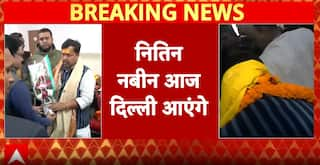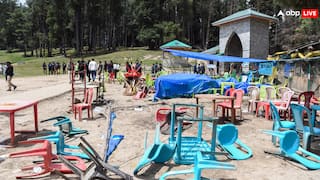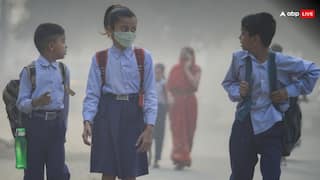Explorer
Opinion: The Greatest Show on Earth? The Indian Elections and a Puzzle
"In every state, a not inconsiderable portion of the candidates have criminal records, though the worst of these candidates are more likely to compete for seats in the elections to the state legislative assemblies".

Indian supporters of India's ruling Bharatiya Janata Party (BJP) wear masks of Indian Prime Minister Narendra Modi during a poll rally in Jammu/ (Photo by STR / AFP)
The Ringling Bros. and Barnum and Bailey Circus described itself for well over a century as “the greatest show on earth”. In truth, however, the Greatest Show on Earth in the post-World War II era has been the general Indian elections. Some have even likened the Indian elections to a circus: though the campaigning begins only a few months beforehand, it is a lively, garrulous, and combative affair where the antics of one candidate after another are likely to lead a person to gasp for air. In every state, a not inconsiderable portion of the candidates have criminal records, though the worst of these candidates are more likely to compete for seats in the elections to the state legislative assemblies. The charges, moreover, are often not for comparatively mild criminal offences, but rather for murder, attempted murder, arson, and rape, among others. No one appears to think it rather odd that candidates who pledge to make the streets safe for women or induce respect for law and order among ordinary citizens should themselves be the most egregious violators of the law.
The element of the bizarre has, of course, a great many other dimensions. Thus, in the 1996 general elections, 1033 candidates contested for a single seat in the Modaurichi constituency in Tamil Nadu. The names were too numerous to be accommodated in a ballot; a booklet was issued. Though the CPM dominates among the traditional communist parties, the dozens of communist parties have often disputed arcane points of ideology as though the interpretation of a particular passage from Marx, Lenin, or Rosa Luxembourg was calculated to shift the fortunes of a country. I suspect the vast majority of the 2,293 political parties that are registered with the Election Commission of India—the Commission recognizes seven as “national” parties, and another 50-60 as parties of demonstrable regional strength—similarly differ from each other in minutiae.
It is, however, the gargantuan nature of this exercise that has long captured the attention of the world. The Indian electorate, at 900 million, dwarfs the electorate in any other country. It grows by leaps and bounds every five years. Over a million polling stations have been set up for the 2019 Lok Sabha elections. One could reel off many more statistics in this vein, though, if I had to hazard a guess without tabulating numbers, perhaps nothing is more impressive than the probable fact that the Indian electorate is greater than the electorate of all and certainly most of the world’s other democracies put together. It is also a singularly impressive fact that, barring the imposition of an emergency by Mrs. Indira Gandhi in 1975, which also extended the life of the 5th Lok Sabha, India has held elections regularly. Mrs. Gandhi did call for elections in 1977 and went down to a crushing defeat. One might say that the desire on her part for adulation from the public and legitimation at the polls curbed her authoritarian instincts. There is much in her decision to seek redemption by putting her political future in the hands of voters that is puzzling and merits introspection.
For the present, however, there is another puzzle in the management of elections that confronts the student of Indian politics. The Election Commission’s guidelines stipulate that a voter should not have to travel more than 2 kilometres to cast a ballot, and the country’s highest polling station is at an altitude of 15,256 feet above sea level at a village in the Spiti Valley where it serves 48 eligible voters. Remarkably, where necessary, election personnel go to a voter to ensure that no eligible vote is ignored. In a remote part of Arunachal Pradesh, a 6-person election team traveled for three days by bus, on foot, and across hilly terrain and rivers to reach a single voter in the the heart of the Gir National Forest, home of the majestic Asiatic lion. Here, at least for one day every few years, it is the majesty of the Indian elections that steals the show. The booth is intended to facilitate the exercise of the democratic rights of a solitary voter, the custodian of the local Mahadev temple known as Banej.
“Bharatdas Darshandas, the lone inhabitant and caretaker of a Hindu temple deep in the Gir Forest,” the correspondent of the New York Times has written, “has become a symbol of India’s herculean effort to ensure that the votes of every one of its 900 million eligible voters is counted.” In a similar vein, the Guardian, visibly impressed by both the country’s faith in democracy and the resolve of the local priest who has “not missed a single election since 2002,” noted that four election officials, escorted by a policemen, trekked for 70 kilometres (45 miles) to ensure that a “69-year old holy man” got to cast his vote “in the world’s biggest democratic exercise.” When we consider that the news from the United States, where the elections determine not only the future of the country but the fate of many other nations, has revolved in good measure around voter suppression, the commitment in India to electoral democracy seems worth celebrating.
However, just exactly how are we to understand this somewhat heroic narrative of a state that lives in thrall of the Indian voter? Many critics of how elections are in reality conducted have pointed to the phenomenon known as ‘booth capturing’, partly in response to which India began to make extensive use of Electronic Voting Machines (EVMs) well over 15 years ago, though some have pointed to manipulation of these very machines as yet another problem. One could also mention various other irregularities. But these matters, important as they may be, are not at the heart of what I would call the puzzle behind the narrative of the sovereignty of the Indian voter. It is not as if the Indian state cares at all for its subjects: after 70 years of independence, India’s record with respect to nearly all the major indices of what conventionally counts for “development” is appalling. Twenty-two of the thirty most polluted cities in the world are in India; the country is the so-called “defecation capital” of the world; a staggeringly large proportion of the population has no access to drinking water; state-run schools are, by everyone’s admission, in absolute shambles; the ranks of the unemployed are enormous. One could go in this vein, ad infinitum: the point is that everything suggests to the complete indifference of the Indian state to the vast majority of the citizens of the country. The Indian state could begin by taking strident steps, as they have done so in China, to clean the air—and save millions of its citizens from early death and future generations from a nightmarish scenario. Whatever one may say of other countries, it is indubitably clear that in India there is no war on poverty but rather a war on the poor—for it the poor who suffer the most from dirty air, water, and soil, not to mention policies that have been designed with the intent of snuffing the life out of them.
Why, then, does the Indian state take such an interest in ensuring the right of every single voter? It won’t do merely to say that political parties are cognizant of the power of the voter, or that in India, as in every other democracy, the “vote bank” has become a critical factor in how political parties position themselves to the public. The state is not just a sum of political parties, and here it is not the conduct of parties that is in in question; moreover, the notion of the “vote bank” does not explain the extreme lengths to which the Indian state goes in ensuring the right of a single voter in the middle of a thick jungle dozens of kilometres from the nearest polling station or in remote Himalayan villages. India must be singular among democracies in sending election officials with voting machines to remote villages, and it certainly does not send doctors to these same villages. Apparently, by the reasoning of the state, the health of these people is less important than their vote—never mind that, if they are dead from lack of medical care, they cannot cast a vote.
Democracies the world over have sadly become reduced to elections. It may be that in India, as some would say, this is most certainly the case. It is even possible to argue that elections, to the extent that they have overwhelmed the imagination and preclude the possibility of a democratic imaginary that moves well beyond the mechanics of voting, are profoundly anti-democratic. That proposition needs careful and deliberate articulation—all the more so because, at least in India, the poor and the marginalized have been, understandably, more protective of the vote than those with privilege. Universal franchise in India only came in with the first general election in 1951-52 and it is to the credit of the country that it was able to hold an election of that magnitude, with an electorate of over 235 million of which 45%, or almost 106 million, cast a vote—and this only four years after independence and 200 years of colonial servitude. I daresay that, in the Indian state’s textbook and “herculean”—the word, the reader might recall, is from the New York Times article—effort to secure the right of every voter, there are residual memories of the anti-colonial struggle. A critical part of this struggle, which Indian historiography does not recognize, was the effort that tacitly every Indian had to make to free themselves of the notion that they were merely part of collectivities—Hindus, Muslims, Brahmins, Sudras, Dalits, Kshatriyas, Bengalis, Tamils, Gujaratis, and thousands of others. The vote is precious to every Indian as it is one public exercise that permits the Indian to individuate herself or himself. I started with the idea of the Indian elections as bearing the ambiance of a circus, but we should not scoff at what is undoubtedly the “Greatest Show on Earth”.
(Vinay Lal is a writer, blogger, cultural critic, and Professor of History at UCLA.)
Disclaimer: The opinions, beliefs and views expressed by the various authors and forum participants on this website are personal and do not reflect the opinions, beliefs and views of ABP News Network Pvt Ltd.
Follow Blog News on ABP Live for more latest stories and trending topics. Watch breaking news and top headlines online on ABP News LIVE TV
View More


























